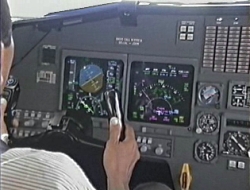Boeing’s test in 2018 with its 777F ecoDemonstrator flying behind another FedEx 777F and Airbus’ Fello’fly demonstration.
Avionics required to enable automated wake surfing, particularly automatic dependent surveillance-broadcast (ADS-B).
ADS-B is now mandatory in the U.S.
Now planes have the avionics to make this possible.
The regulations say don’t do it. So the next step is getting the regulations changed.
We will do it first with cargo aircraft, and we are working with Airbus on the regulatory aspects.
Agreeing on the procedures between aircraft, operators and air traffic control (ATC) that will enable wake surfing.
There are two things wake surfing is not. The first is a drag reduction technique. Instead, to maintain steady, level flight within the updraft from the wake vortex, the aircraft must pitch nose-down so it is descending relative to the upward moving air. The lift vector, normally vertical, is tilted slightly forward. This counters some of the drag, requiring less thrust to maintain horizontal flight. This reduces fuel consumption.
The second is traditional formation flying. Military aircraft fly in close formation, a few wingspans apart. Commercial aircraft would fly in extended formation, up to 1 nm apart, on what the industry prefers to call “cooperative trajectories.” This greater distance—10 or more wingspans for commercial aircraft—reduces the fuel-saving benefit but eases the workload on the pilots.
For Boeing’s 777F ecoDemonstrator flight test, Aviation Communication & Surveillance Systems modified its traffic collision alert system (TCAS) to perform airborne interrogation of the lead aircraft for EHS data. The system sent ADS-B and EHS data to a flight-test laptop that hosted the wake prediction algorithm on the trail aircraft. The laptop then sent a command to the autopilot’s localizer control law, which was used to keep the aircraft on station relative to the wake. “ADS-B plus TCAS may work.







Nenhum comentário:
Postar um comentário